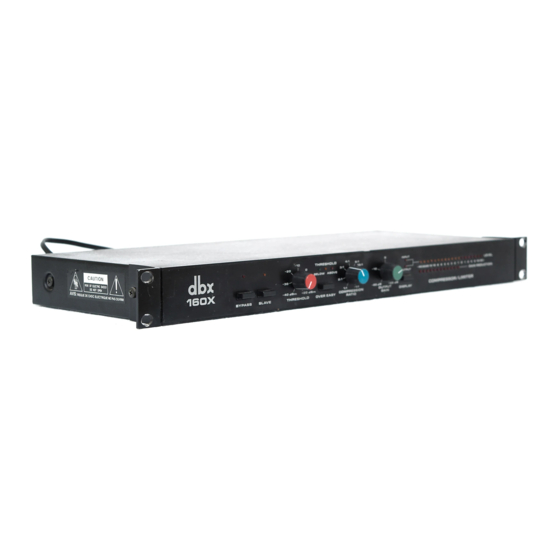dbx 160X Buku Petunjuk - Halaman 7
Jelajahi secara online atau unduh pdf Buku Petunjuk untuk Peralatan Perekaman dbx 160X. dbx 160X 8 halaman. Professional single-channel
compressor/limiter
Juga untuk dbx 160X: Buku Petunjuk (17 halaman)

4.0 TYPICAL APPLICATIONS
4.1 SMOOTHING
VARIATIONS IN
VOCAL
LEVEL
When the distance between a vocalist and a
microphone changes, variations in signal level occur.
Start with the 160X adjusted for low compression
(around
2:1)
and adjust the THRESHOLD control
for optimum
results,
then increase
RATIO
if
necessary.
.
.
4.2 SMOOTHING VARIATIONS IN
INSTRUMENT LEVEL
To
achieve
a smoother
electric-bass
sound,
compress the instrument's output with a ratio of
about 4: 1. Compression lessens the loudness
variations among the strings and increases the
sustain. Other instruments, such as horns, vary in
loudness depending on the note being played,and
benefit similarly.
NOTE: When compressing a stereo program with a
pair of 160Xs, the factors affecting a compression
curve, and the actual compression and threshold
settings, are like those previously covered with
reference to single channels of program material.
However, it will generally be found that large
amounts of compression are more audible in a
mixed stereo program than they might be on the
separate tracks that were mixed to create the
program.
4.3 RAISING A SIGNAL OUT OF A MIX
Since reducing dynamic range increases the
average
signal level and meter readings by a small
amount, a single track can be raised out of a mix
by boosting its level slightly and applying com-
pression. It is also possible to separate certain
vocals or instruments from a mono
program
already mixed by following the procedure in
Section 4.6.1.
4.4 PREVENTING TAPE SATURATION
With programs of widely varying levels, com•
pression
can prevent recording levels from satur•
ating
tape
tracks (see also Section 4. 7
.1).
4.5
SPEAKER
PROTECTION
Compressors are frequently used to prevent
excessive program levels from damaging drivers
in
a
sound-reinforcement system. Limiting also
benefits intelligibility by allowing low-level input
signals
to be reproduced through·the system at
higher volume.
In a musical performance, this
provides
additional intimacy as the vocalist's
whispers are heard clearly at each seat in the house.
The
Over
Easy curve utilized by the 160X permits
a very high
amount of compression (10:1 or
greater)
to be used in many situations. Vocalists
and musicians don't get the sense of being
"choked
back", but high average levels can be maintained
without the speaker damage which would
norn,ally
occur
due to excessive heat buildup
in the drivers.
In circumstances where the 160X is expected
to
cause no change
in gain unless an emergency
arises (wildly excessive levels) some operators
set the RATIO to•:
1, the THRESHOLD to the
highest permissible level, and operate the unit in
hard-knee mode. (In hard-knee mode, the 160X
will perform in the manner of
Its
predecessor, the
16Q.) As
a
general rule, the comprnaors should be
as clou
to
th11 •mplifi11r, • p0$$ibl•
in the signal
chain. If the 180X Is placed before the EQ, for
example,
1
potentially damaging boost in EQ
won't bG seen by
the
unit and the speakers may
be damaged.
(See
Section
4.8.2.)
For maximum
sound-pressure levels, large sound-reinforcement
systems frequently
use a separate
compressor on
each output of the electronic crossover(s). For a
stereo sounckeinforcement system, stereo
strapping
cabin
should be run between the 160Xs
in each band (low-low, .mid-mid,.etc) •
•
4.8 INFINITY+T~ COMPRESSION
.
It has been noted that with a full-scale
Infinity+ setting of-1.1, a 1 dB
decreasa
of input level above THRESHOLD causes a
1 dB incmnt1 of output level. It can
be seen
how this differs from the full counter-
clockwise setting of 1
:
1, where the transfer
function is linear (e.g., a 1 dB
increas11
of input
level causes a 1 dB
decrease
of output level).
A total dynamic reversal of the entire program
being processed will not occur unless the
THRESHOLD is
set
very low (e.g., -40 dBm)
and all the program material falls above the
threshold level. More often, some of the
program input will
be
below threshold, and
will therefore have normal dynamics - that
is, the output level will change linearly with
changes of input level. As the input level rises
above threshold, however, the output level will
begin to decrease. The audible results will differ
with
different types of program material and
different settings. With instruments havina_fast
attack times, such
as a
picked guitar,
a
harpsichord,
or a drum, a low threshold will all but eliminate
the attack transient. Interesting effects can be
obtained by setting a moderate threshold with
instruments with a slower attack, such as wind
instruments or bowed strings; the level will build
normally up to the threshold, then begin going
lower, the output will become very quiet as the
instrument is generating its loudest sound, perhaps
quieter than when the note first began.
4.7 USING THE DETECTOR INPUT
4.7. 1
Detector EQ For Signal Enchancement
It
is
possible to separate certain vocals and
instruments from a mix by frequency-weighted
compression. With an equalizer ioserted ahead of
the detector input (but not in the audio path), the
equalization settings do not shift the timbre or
frequency response of
the
audio signal. They
merely alter the threshold response of the com-
13
